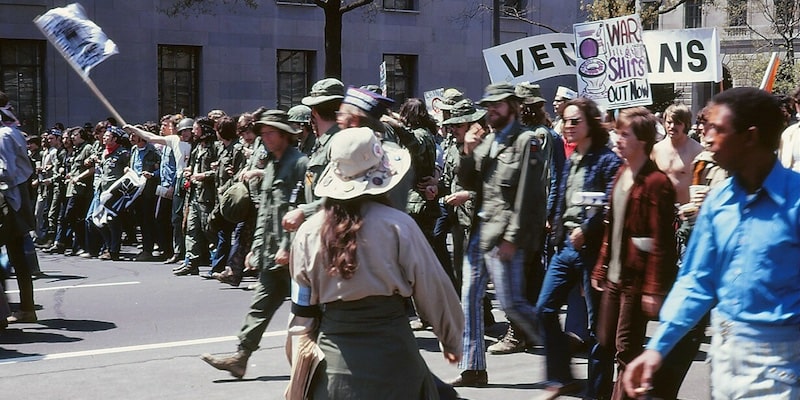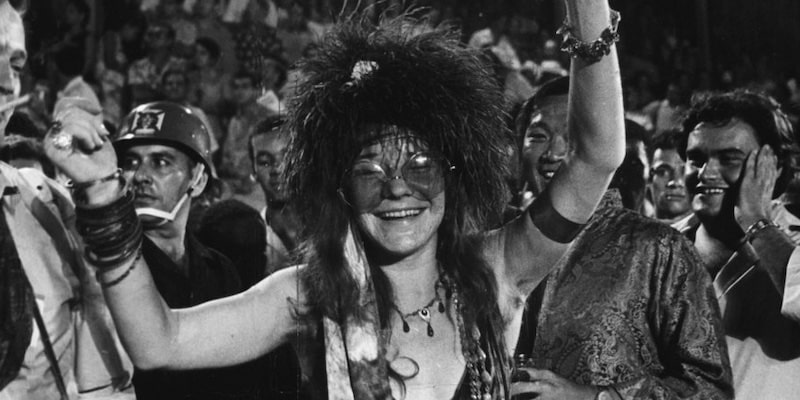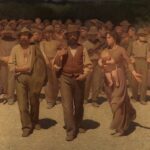We explain what the hippie movement was, its origin and its characteristics. Also, its icons and main ideas.

What was the hippie movement?
The hippie movement was a countercultural social movement that emerged in the United States in the 1960s and spread to different parts of the world. It was a popular expression of young white middle class people against the values of conservative society, repression, consumption and capitalism.
The hippie movement promoted pacifism, sexual freedom, the development of spirituality, community life and conscious consumption (for the care of the environment and respect for animals). In search of new ideas to support their way of seeing life, hippies took many teachings from Eastern philosophies, such as Hinduism and Taoism.
Most of their protests and street demonstrations were against the Vietnam War. The most famous slogans of their marches were: Give peace a chance (“Give peace a chance”), Make love, not war! (“Make love, not war”) and Hell no! We won't go! (“Hell no! We're not going!”, in reference to the Vietnam War).
Hippies were identified by their style, their clothing, their way of life and their activities. Women and men left their hair long, wore baggy pants printed with psychedelic drawings. They were looking for a freer life than the one they had in their parents' house, so they left there to practice ways of living in community.
Furthermore, the hippie movement was closely related to music, rock, large festivals and the consumption of alcohol and different types of drugs. Among its main musical icons were Janis Joplin, The Doors, The Beatles, Jimi Hendrix and Jefferson Airplane.
How did the hippie movement emerge?

The hippie movement emerged as a protest to the hegemonic values established by capitalist consumer society known as the “American way of life.” Since the end of World War II (1939-1945), the United States government promoted an economic model based on the constant consumption of different goods and services.
In this way of life, the family was the nucleus of society: the man worked and maintained the household economy, and the woman took care of domestic and child-rearing tasks. Christian, bourgeois and conservative values were promoted in which good social conduct took precedence.
Furthermore, within the framework of the Cold War, the US government promoted anti-communism and the repression of any free thought that was critical of capitalism. He maintained that he had to prevent the advance of communism in other parts of the world and thus justified his military intervention in the Vietnam War (1955-1975).
In this context, the hippie movement emerged as a cultural manifestation of young people who were against the values imposed by the consumer society, the values of the conservative family and the repression of the government inside and outside the country.
The hippie movement arose in a broader context of cultural transformations. In the same decade, African Americans' fight for equality grew with the leadership of Martin Luther King. For its part, the feminist movement had a new impulse and began to question the gender roles established in social life.
Background: the hipsters and the Beat generation

The hippie movement began in the early 1960s among students at some universities in the United States. Its name derives from another cultural movement of the previous decade known as hipster.
The hipsters They were middle class young people who listened to jazz and disbelieved in the values promoted by capitalism. They read the works of writers like Jack Kerouac and Allen Ginsberg. The movement hipster It expanded in the 1950s and was also known as the “Beat generation.”
The hippies differentiated themselves from the Beat generation by developing a vision focused on freedom, expression and pacifism. They shared criticism of government repression and consumer society, but they were differentiated by their style and their vocation for generating alternative community spaces.
Characteristics of the hippie movement
With the expansion of the hippie movement, young people of different ages became involved in it. One of its main characteristics was its free way of life which manifested itself in different cultural practices:
Outfit
The hippies identified themselves with clothing that differentiated them from the rest of society. Among them, jean pants, which had already spread among other countercultural movements (because “they eliminated social class differences”).
Hippies included the use of colors and shapes from nature, and opted for loose clothing made of comfortable fabrics. Many women stopped wearing bras and the use of miniskirts became widespread.
Pacifism
The hippies were pacifists and were against the use of military violence. At that time, the United States had become involved in the Vietnam War (1955-1975) and hippies were participating in protests against the war.
Only part of the movement believed in political activism and demonstrated in the streets. Other hippies promoted peace through art, debates, the use of symbols and the practice of other alternative forms of sociability.
Trips
One of the main influences of the Beat generation on the hippie movement was reading the book On the wayby Jack Kerouac. This work was about inner self-exploration through adventure and road trip.
The hippies created a way of life from spontaneous trips light on luggage, without comforts and, many times, without a destination. With them, hitchhiking became popular (that is, travelers asking vehicles passing by on the road to take them to the next destination).
community life
many hippies gathered in communities. For the most part, these were young people who left their homes in search of other forms of socialization and coexistence.
Generally, the communities were located in spaces with greater contact with nature, far from cities. Community life was organized based on certain communist principles, with the aim of becoming self-sustaining, and an internal organization in which tasks were distributed for the subsistence of the entire group.
sexual freedom
The hippies promoted individual freedom in all its aspects and, among them, highlighted the importance of free love. They maintained that the ways of relating established by society were oppressive.
They were against institutions such as marriage and renounced religious puritanism that placed limits on sexual practices. Instead, they believed that love should not be limited to a single person and that while maintaining a romantic relationship with one partner, one could have sexual relations with others.
Spirituality
Hippies believed that Western religious expressions (especially those of Christianity and Judaism) did not represent their beliefs. Instead, believed in the need to develop the spirit through self-discovery.
This feeling connected them with Eastern philosophies, religions and practices, such as Hinduism, Taoism, Zen and yoga. They also created different types of mystical communities that followed the teachings of a teacher.
Music
The hippie movement It was also characterized by its close connection with music and recitals. They listened to psychedelic rock, blues, groove and rebellious folk artists, whose lyrics represented hippie values and criticized the norms of dominant society.
At that time, the culture of musical consumption changed and large outdoor festivals appeared, such as the Monterrey Pop Festival and the Woodstock Festival. Iconic musicians of the hippie movement include The Beatles, Jimi Hendrix, Pink Floyd, Janis Joplin, Jefferson Airplane, The Who, Creedence Clearwater Revival, Bob Dylan, Pete Seeger, Joan Baez, BB King and Neil Young.
Drug use
many hippies consumed different types of narcotics. They did it for fun or with the aim of reaching altered states of consciousness in search of self-knowledge. Among the most common uses were marijuana, hashish, LSD and hallucinogenic mushrooms.
Icons of the hippie movement

Among the main icons of hippie culture are:
- Summer of Love It was an open-air festival that took place near the city of San Francisco in 1967. It was one of the largest concentrations of the hippie movement in history, with the presence of more than 200,000 people from all over the world. The most representative songs of that moment were “San Francisco (be sure to wear some flowers in your head)”, performed by the band The Mamas & The Papas, and “All you need is love”, by The Beatles.
- Woodstock Festival. In 1969, the most representative music festival in hippie history was held. It began with an opening ceremony led by mystical guru Swami Satchidananda and was promoted as “three days of music and peace.” It took place on a farm of more than 200 hectares and featured performances by 32 artists or musical bands and the presence of more than 400,000 spectators.
- Volkswagen Bus 1963. This vehicle became an icon for hippie travelers due to a photograph that circulated in different media of the time. The photo portrayed a van painted with psychedelic motifs, symbols and messages representative of hippie culture, on its way to the Woodstock Festival.
- flower power (the power of flowers). It was a hippie slogan that represented their pacifist ideology and became an icon of the hippie movement as a whole. It is often linked to a photograph taken in 1967 in a protest against the Vietnam War. In the photo, a protester is seen offering a flower to a soldier who is carrying a gun.
End of the hippie movement
In the mid-1970s, the hippie movement It lost its strength and became disjointed. There is no precise reason to explain the end of this movement. However, different factors from the political and social context of the time can be identified that are related to the end of the movement.
On the one hand, in 1973, the United States government negotiated peace with the communist armies of North Vietnam and withdrew its armies from that country. Therefore, The Vietnam War came to an end for the Americans and, in this way, one of the main focuses of struggle of the hippie movement disappeared.
In the musical field, an era was also ending. In 1970, the band The Beatles broke up and Jimi Hendrix and Janis Joplin, two of the most representative artists of the movement, died.
On the other hand, many hippie communities showed difficulties in self-sustaining and they ended up dissolving. Free love and sexual freedoms continued to exist among the population, but they were no longer defended through public demonstrations, but rather remained part of people's private lives.
document.addEventListener(“DOMContentLoaded”, (e) => {
var sliderContainer, slider;
sliderContainer = document.getElementById(‘block_1adaddf3b416ad100e1756f91608676d’);
if (typeof initSlider !== ‘function’) {
console.log(‘Swiper haven\’t been loaded’);
sliderContainer.className += ‘ fw scroll-snap’;
return;
};
options = {
direction: ‘horizontal’,
speed: 1000,
slidesPerView: ‘auto’,
// slidesPerGroup: 1,
centerInsufficientSlides: true,
// centeredSlides:true,
spaceBetween: 15,
breakpoints: {
720: {
// centeredSlides: false,
// slidesPerGroup: 2,
spaceBetween: 25
},
},
pagination: {
el: ‘.swiper-pagination’,
type: ‘bullets’,
clickable: true
},
}
slider = initSlider(sliderContainer, options);
})
References
- Issitt, M. (2009). Historical overview. Hippies. A Guide to an American Subculture. Bloomsbury Publishing USA.
- Miller, T. A. (2012). The Hippies and American Values. University of Tennessee Press.
- The Editors of Encyclopaedia Britannica. (2023). Hippie. Encyclopedia Britannica. https://www.britannica.com/





